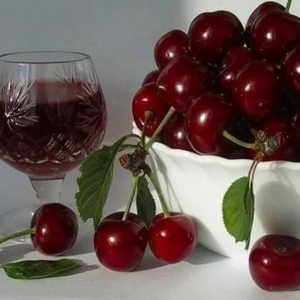Wine from Apricot, cooked by the experienced hands of winemakers, serves as a reminder of the sunny summer with its bright color and thin, sweetish aroma. For a light, without obvious sourness, the taste of it is loved on all feasts, and the smell of apricot seed reminds of the squeak of the famous Amaretto liqueur. Prepare summer particle in a glass is quite easy to know the secrets and features of the creation of homemade wine from Apricot.
Secrets
- For the preparation of wine use the fruit of the first freshness. Did you choose or misappropriate apricots, otherwise they will strongly spoil the taste of the future drink.
Ripe fruits are collected from trees. Raise apricots, even if the most ideal, is not recommended from the ground. Fallen fruits will affect the shades of the taste of homemade wine, literally destroying the whole work of winery. - Apricots, designed for the manufacture of wine, do not wash. If they were waved at the unaware, then the wine is prepared only when the wine yeast is added to the ingredients. The whole secret in natural yeast contained on the skin of apricots. They are very unstable and easily washed away even with rain, so they do not recommend doing wine from purchased apricot. In this case, there is no possibility to check whether the fruits were exposed to some processing.
- If the wine is planned to do with yeast, then skin with apricot is removed. Otherwise, this is not necessary to do this, since all the taste and aromatic properties of the future drink are associated with the peel.
- The bones of apricot would attach a bitter odor drink, similar to the smell of almond, but they are always removed. This is due to the sytic acid. Its in the bone contains too much, it is dangerous for a person and harm health even in small doses. If you definitely want to additionally flavor wine to it, you can add a nutmeg.
- From the moment the fruits were cleared and until the new wine bottle was bought off, the drink cannot be contacted with light or air. The pulp of apricot in the air becomes darker because of the elected iron, and the wine begins to change its taste notes. The light only speeds up the process of damping the beverage, which is why the bottles with this wine are kept in the dark at - 10 degrees Celsius.
- The shelf life of the apricot wine is 3 years, to fully feel his taste and enjoy the smell in a year or two from the moment of its manufacture.

Classic recipe
The recipe for the creation of apricot wine without yeast is considered classic and gained great fame. Due to the fact that it does not require many components. For cooking required:
- 1 kg of purified and wipes apricot wipes
- As much sugar
- 3.5 liters of water
Recipe:
- Apricots put on their hands in mashed hands. Take an enamelted tank of 7 liters and shift the apricot mass there. If there is no such large enamel dishes, it can be replaced with a stainless steel capacity.
Water is warm to a temperature greater than room and, when it reaches about 30 degrees, it is mixed with 500 g of sugar. This sweet mixture poured apricots, cover the tank with a cloth and rearranged to heat for 8 hours. - When 8 hours are expired, a spoon made of wood or hand mixed the resulting mixture and repeat the mixing twice every day. It is necessary that the emergence of mezga - the sediment dropped and separated from the liquid. After the first 24 hours is completed, it is starting to mix up to three times in the grid. When foam or hissing appear, it serves as a signal to the fact that the process of winemaking brings fruit. If there is no fermentation, the mixture add wine yeast.
- After 5 days, juice is drained. The precipitate itself is shifted into a four layer of gauze and pressed into the same container where the juice was overflowed. Sugar fall there and mixed again, and then overflow juice into a glass bottle. The volume of this bottle should exceed the amount of juice by 30% minimum. After that, the bottle is closed by hydraulic or put on top of a rubber glove with a punctured needle index finger.
- The bottle with juice is kept in heat and hidden from the sun's ray week, then 250 g of liquid is mixed, mixed with sugar residues and poured into a bottle. After that, she does not touch it for another month, although this time segment is very conditional. It all depends not from the very time, but from the behavior of the fluid in the container. Almost ready-made wine will be when the hydraulic was walked or the glove will fall. At the same time, the mezga should fall on the bottom, and the transparent liquid to be over it.
- When the wine is completely free from the sediment, it is transfused using a tube into other bottles to continue to settle. Capacities are chosen so that they are almost completely filled. After filling, they are closed to prevent air penetration to the guilt.
- Wine will be defended for about 4 months in the coolness and it will need the attention of winery, because it is often taken to wander and after transfusion. If this happens, then it is overwhelmed with the help of a tube to get rid of the sediment. When the height of the precipitate exceeds 2 cm. Wine is also transfused into another container.
- After that, the wine store 4 years or drink, despite the fact that his taste will raise the full force in a minimum one after a year. Apricot wine fortress does not exceed 11%.

The simplicity of the production of wine from Apricot houses on a classic recipe is easily compensated by attention, which wine requires in the fermentation process. Nevertheless, this delicious, amazing drink costs each minute spent on it.






























